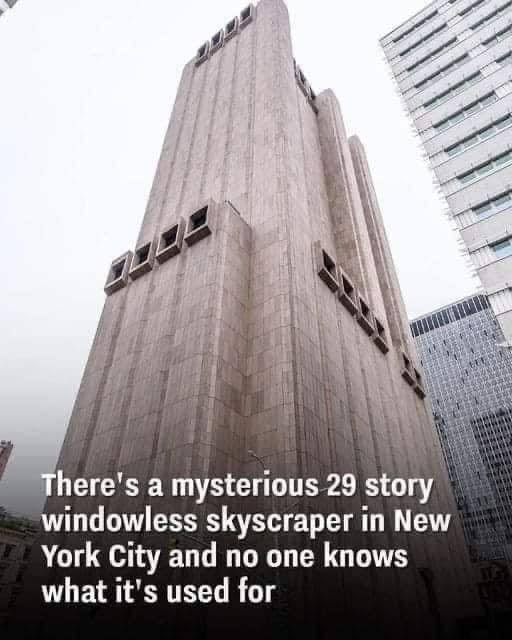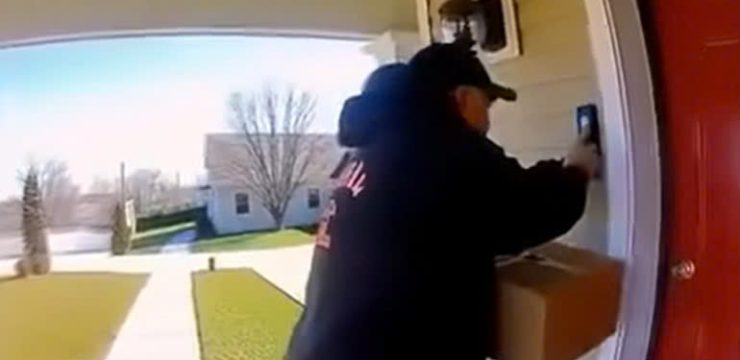In the heart of Lower Manhattan stands one of New York City’s most mysterious buildings—a towering 29-story structure known as 33 Thomas Street, or by its codename “Titanpointe.” At 550 feet tall, this massive skyscraper lacks a single window, making it an eerie standout among its glass-covered neighbors.

Designed in 1974 by the architectural firm John Carl Warnecke & Associates, the building was originally constructed to survive a nuclear attack, intended to house crucial telecommunications equipment and serve as a secure communications hub. Built from concrete and granite, 33 Thomas Street has a brutalist design that dominates the skyline with its dark, looming presence. At night, it casts an ominous figure with no interior lights to break its silhouette, and during the day, it creates an imposing shadow across nearby streets. The only external features are square vents that emit a faint, constant hum, a subtle presence that is often drowned out by the noise of city traffic. For decades, locals have speculated about its purpose, nicknaming it the “Long Lines Building.” But despite being a striking architectural oddity, its true function has remained largely hidden—until now.
Thanks to classified documents leaked by NSA whistleblower Edward Snowden and subsequent investigations by journalists and former AT&T employees, the world has gained a deeper glimpse into what might actually be going on inside. Far from being just a telecommunications relay center, 33 Thomas Street has reportedly served as a key surveillance site for the National Security Agency (NSA). Inside the building lies a critical international gateway switch that facilitates phone traffic between the United States and countries around the world. It’s suspected that the NSA used this hub to secretly intercept those calls, monitoring communications not only from foreign adversaries but also from international organizations such as the United Nations, the International Monetary Fund, and even friendly governments.
The facility, shrouded in secrecy and heavily fortified, has earned a chilling reputation as a nerve center for intelligence gathering. While the NSA’s collaboration with telecommunications giant AT&T is not new, the Snowden documents revealed the extent to which AT&T’s infrastructure may have supported surveillance efforts. Though there’s no definitive public evidence confirming the NSA’s direct occupation of 33 Thomas Street, the material disclosed paints a compelling picture.
The documents suggest that AT&T willingly cooperated with intelligence agencies for decades, allowing access to its systems to support government monitoring operations. Still, many of the specifics remain classified, and both the NSA and AT&T have remained largely silent on the matter. Elizabeth Goitein, co-director of the Liberty and National Security Program at the Brennan Center for Justice, sees 33 Thomas Street as more than a building. She considers it symbolic of a broader concern—how deeply private communication networks have been integrated with government surveillance. “This is yet more proof that our communications service providers have become, whether willingly or unwillingly, an arm of the surveillance state,” she explained.
The idea that American surveillance would only target foreigners has been challenged by this revelation. The building’s secrecy, function, and government ties raise questions about how much privacy Americans actually have and who is watching whom. Adding to the intrigue, while AT&T owns most of the space within the building, Verizon also has a presence there, further complicating the narrative. And although a 2015 joint report by The New York Times and ProPublica confirmed AT&T’s deep cooperation with the NSA, no concrete evidence was produced to prove that the agency officially occupied 33 Thomas Street. Nonetheless, the clues—Snowden’s files, technical data, and expert analysis—are enough to convince many that Titanpointe is far more than it appears.
In a digital world where communication is constant and surveillance capabilities are growing ever more sophisticated, 33 Thomas Street represents the gray zone between national security and civil liberties. It’s a place where wires, switches, and servers may quietly carry the weight of both progress and intrusion. Whether or not we’ll ever know the full extent of the building’s role in intelligence operations, it continues to serve as a potent symbol of the age-old tension between privacy and protection. For now, it stands silently in Lower Manhattan, casting its long shadow—both literal and metaphorical—over the ongoing debate about transparency, surveillance, and the price of security in the modern era.





